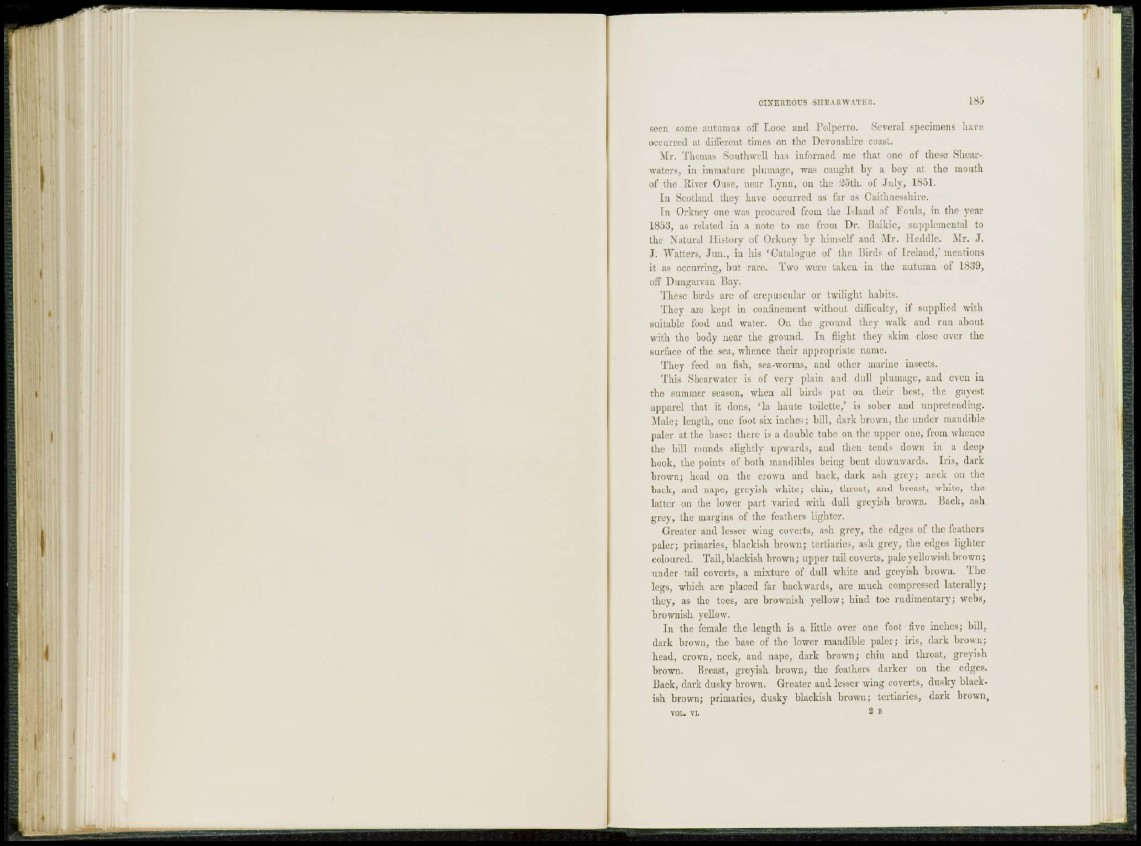
0INEREOTJS SHEA RWA.TER. 185
seen some autumns off Looc and Polperro. Several specimens have
occurred at different times on the Devonshire coast.
Mr. Thomas Southwell has informed me that one of these Shearwaters,
in immature plumage, was caught by a boy at the mouth
of the River Ouse, near Lynn, on the :35th. of July, 1851.
I n Scotland they have occurred as far as Caithnesshirc.
In Orkney one was procured from the Island of Foula, in the year
185o, as related in a note to me from Dr. Baikic, supplemental to
the Natural History of Orkney by himself and Mr. Heddle. Mr. J.
J. Watters, Jun., in his 'Catalogue of the Birds of Ireland,' mentions
it as occurring, but rare. Two were taken in the autumn of 1839,
off Dungarvan Bay.
These birds are of crepuscular or twilight habits.
They are kept in confinement without difficulty, if supplied with
suitable food and water. On the ground they walk and run about
with the body near the ground. In flight they skim close over the
surface of the sea, whence their appropriate name.
They feed on fish, sea-worms, and other marine insects.
This Shearwater is of very plain and dull plumage, and even in
the summer season, when all birds put on their best, the gayest
apparel that it dons, 'la haute toilette,' is sober and unpretending.
Male; length, one foot six inches; bill, dark brown, the under mandible
paler at the base: there is a double tube on the upper one, from whence
the bill rounds slightly upwards, and then tends down in a deep
hook, the points of both mandibles being bent downwards. Iris, dark
brown; head on the crown and back, dark ash grey; neck on the
back, and nape, greyish white; chin, throat, and breast, while, the
latter on the lower part varied with dull greyish brown. Back, ash
grey, the margins of the feathers lighter.
Greater and lesser wing coverts, ash grey, the edges of the feathers
paler; primaries, blackish brown; tcrtiarics, ash grey, the edges lighter
coloured. Tail, blackish brown; upper tail coverts, pale yellowish brown;
under tail coverts, a mixture of dull white and greyish brown. The
legs, which are placed far backwards, are much compressed laterally;
they, as the toes, are brownish yellow; hind toe rudimentary; webs,
brownish yellow.
I n the female the length is a little over one foot five inches; bill,
dark brown, the base of the lower mandible paler; iris, dark brown;
head, crown, neck, and nape, dark brown; chin and throat, greyish
brown. Breast, greyish brown, the feathers darker on the edges.
Back, dark dusky brown. Greater aud lesser wing coverts, dusky blackish
brown; primaries, dusky blackish brown; tcrtiarics, dark brown,
VOL. VI. 2 B